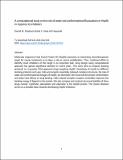| dc.contributor.author | Shadrack, Daniel M. | |
| dc.contributor.author | Swai, Hulda | |
| dc.contributor.author | Hassanali, Ali | |
| dc.date.accessioned | 2020-08-21T12:35:44Z | |
| dc.date.available | 2020-08-21T12:35:44Z | |
| dc.date.issued | 2020-05 | |
| dc.identifier.uri | https://doi.org/10.1016/j.jmgm.2019.107510 | |
| dc.identifier.uri | https://dspace.nm-aist.ac.tz/handle/20.500.12479/881 | |
| dc.description | This research article published by Elsevier Inc.,2020 | en_US |
| dc.description.abstract | Molecular chaperone Heat Shock Protein 90 (Hsp90) represents an interesting chemotherapeutic target for cancer treatments as it plays a role in cancer proliferation. Thus, continued effort to identify novel inhibitors of this target is an important task. Drug design using computational approach has gained significant attention in recent years. This work aims to propose docking protocols to re-purpose FDA-approved drugs targeting Hsp90. Sensitivity of results to different docking protocols such apo, holo and receptor ensembles (relaxed complex) structures, the role of water and conformational changes of Hsp90, are described. We show that the protein conformation and water have effects on drug binding. Holo relaxed complex receptors ensembles improves the binding energy of ligands to the protein. We also compare and contrast structural stability of three drugs namely: ezetimibe, pitavastatin and vilazodon in the Hsp90 protein. The results obtained serves as a possible basis towards developing Hsp90 inhibitors. | en_US |
| dc.language.iso | en | en_US |
| dc.publisher | Elsevier Inc. | en_US |
| dc.subject | Research Subject Categories::NATURAL SCIENCES | en_US |
| dc.title | A computational study on the role of water and conformational fluctuations in Hsp90 in response to inhibitors | en_US |
| dc.type | Article | en_US |

